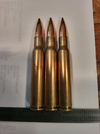I'm reloading several hundred rounds of LC-66 that I've had stored for years. Primer pockets have been swaged/reamed and primers seated just fine. Cases have been trimmed to between 2.484" and 2.490.
Here is my load data:
Bullets: Nosler .308 168gr HPBT
Powder: IMR-4895 - 45gr
OAL per Lyman 49th Edition: 3.300"
I'm using a Lee Classic Turret Press, but only one stage at a time; decap/resize everything, then seat everything - no back and forth.
The problem is when I'm seating the bullets (using 2-die RCBS set) I get inconsistent seating depths. Most depths are ~ 3.295 to 3.300". But around 20% have an OAL greater than 3.300" with some as short as 3.280". I just set those aside and fix them when I'm done with a batch.
In the photo are three examples from one batch of 60 rounds.
Bullet on the left OAL = 3.280"
Bullet in the middle OAL = 3.300"
Bullet on the right OAL = 3.310"
Of the 60 rounds I reloaded today:
45 were between 3.295" and 3.300"
13 had an OAL over 3.300"
2 were short around 3.280"
Overall, the OAL range for this batch of 60 rounds was 3.280" to 3.310".
Is that normal? How close to the OAL in the book is acceptable? If it needs to be spot on, how does one insure consistent seating depth?
Oh, and I measured a random sample of the Nosler 168gr bullets and they ranged from 1.198" to 1.214"
Thanks!

Here is my load data:
Bullets: Nosler .308 168gr HPBT
Powder: IMR-4895 - 45gr
OAL per Lyman 49th Edition: 3.300"
I'm using a Lee Classic Turret Press, but only one stage at a time; decap/resize everything, then seat everything - no back and forth.
The problem is when I'm seating the bullets (using 2-die RCBS set) I get inconsistent seating depths. Most depths are ~ 3.295 to 3.300". But around 20% have an OAL greater than 3.300" with some as short as 3.280". I just set those aside and fix them when I'm done with a batch.
In the photo are three examples from one batch of 60 rounds.
Bullet on the left OAL = 3.280"
Bullet in the middle OAL = 3.300"
Bullet on the right OAL = 3.310"
Of the 60 rounds I reloaded today:
45 were between 3.295" and 3.300"
13 had an OAL over 3.300"
2 were short around 3.280"
Overall, the OAL range for this batch of 60 rounds was 3.280" to 3.310".
Is that normal? How close to the OAL in the book is acceptable? If it needs to be spot on, how does one insure consistent seating depth?
Oh, and I measured a random sample of the Nosler 168gr bullets and they ranged from 1.198" to 1.214"
Thanks!

Last edited:


